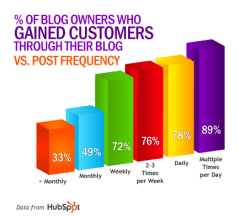A website is a great starting point and an important centerpiece of your digital marketing efforts, but you really need more than a website to optimize market performance.
Why you need more than a website
Here are 4 reasons:
- SEO
- Build relationships with customers and prospects
- Amplification and de-commoditization
- Analytics help optimize performance
SEO
Search Engine Optimization (SEO) creates awareness of your brand by moving it up on the results pages when folks in your target market search for products and services.
With over 200 ranking factors, Google includes more factors than just those on your website. In fact, in an effort to deliver the most valuable links first, Google looks for indicators that folks approve of your page — things like social engagement (all those likes, shares, and comments).
While there’s no indication that bringing more visitors to your site results in higher sales, but, all things being equal, it’s better to have more visitors than less as visits represent opportunities.


While a blog is technically part of a website, not all websites contain a blog, so I list it as something more than a website.
Build relationships with customers and prospects
First, let’s talk about why you want to build relationships, not just engage in transactions with customers.
- they help promote your business to friends [source]
- customers who engage with the company are more likely to be repeat customers [source]
- retaining existing customers is cheaper (by 5X) than replacing them [source]
- customers who have a relationship with a business are more loyal and less likely to be lured away by competitors [source]
So, building relationships has a huge benefit for organizations that flows directly to the bottom line rather than just giving customers and managers some touchy feeling goodness.
That said, it’s really hard to build relationships with customers on a traditional website. Certainly, adding a forum or other user elements can help your website engage customers, although those efforts will be mostly invisible to prospects. And, forums and other tools are really more than a website.
Social media is a great tool for building customer relationships and, because these interactions are public, it brings in new customers, as well. Social media, however, is the biggest addition to digital marketing and is much more than a website, although the website and social profiles are likely linked. Here are some great tools for using your social networks to build a relationship with customers and prospects.
Image courtesy of Data Mentors
Email marketing, which is also more than a website, not only help build valuable relationships, they have the highest conversion rates of any tactic except your website.
Amplification and de-commoditization
Social networks, not only amplify your message, especially on Facebook where every like, comment, and share shows your post to the user’s network, but it acts to de-commodify the message.
Not familiar with the term, de-commodification, no problem.
We’ve become jaded in our culture by commercial messages. We’re bombarded with messages telling us that products will salve our problems and that each is the greatest, yet we’re disappointed time and time again by these products. Eventually, we don’t believe anything the brand tells us.
Enter our social networks. We like the folks in our social network despite the fact we may not know many of them personally.
And, we really don’t care. Those of us old enough to remember Blockbuster video stores had the experience of a total stranger offering suggestions on renting movies — and we believed them because we viewed them as objective recommendations.
Well, the same thing works in social media.
We believe our friends’ assessments (good and bad) over commercial messages sent by brands. Even when the friend is simply sharing the brand’s message rather than constructing a recommendation.
Analytics

It’s hard to have any conversation about digital marketing performance without discussion analytics.
Even though some of your most important analytics may come from your website, they’re certainly more than a website.
In crafting your marketing strategy, consider KPIs (key performance indicators) across your various marketing tactics, then monitor performance using something like this BI dashboard from Microsoft.
Be careful in constructing KPIs to ensure you’re assessing both bottom of the funnel results (sales, lead generation, average order size, etc), but those at the top of the funnel that impact bottom of the funnel performance (visits, CTR, time on site, shares, and vanity metrics such as number of followers).
Final thoughts
While a website is a necessary tactic in today’s world, it’s not sufficient to optimize your market performance. Consider adding:
- A blog and creating valuable content you share at least once per week
- An email marketing campaign supported by both list building activities and newsletters that share valuable information not distributed through other sources like your blog and social networks
- Social media, which again requires a two-prong approach of building and sharing
- A BI dashboard capable of informing future actions to optimize returns
- Two-way communication between customers and your brand that builds engagement and encourages sharing
- A customer journey map detailing the sources and sites your customers travel in their journey to buying your product
